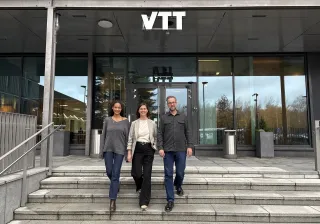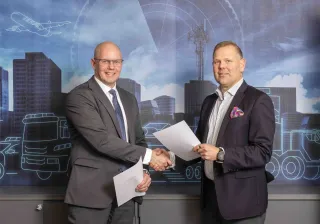The rapidly evolving field of urban air mobility (UAM) will open opportunities for many services: drones for good could, for example, transport samples to healthcare centres or spare parts in urgent maintenance cases. For this business to truly take off, we need to understand how and why this can happen. Finland is pioneering new forms of UAM solutions in the forefront of a small number of countries and can lead the way for European medium-sized cities and their economic areas. VTT’s experts are driving the driving the initiative forward in Finland and now invite Finnish companies to take part in this holistic development work.
Urban air mobility of the future is generating interest around the world, but there is still a huge need for further understanding of the economic and societal factors involved. This is reflected in the extensive scientific assessment delivered to the International Civil Aviation Organization (ICAO) by the International Forum for Aviation Research (IFAR). The report was produced by 27 leading aeronautics research institutions and 80 scientists from different countries. The work was coordinated by the German Aerospace Center (DLR), NASA and the National Research Council Canada (NRC). VTT represented Finland in the collaboration.
– The report analyses UAM from both industrial and scientific perspectives. Based on these perspectives, further research is needed, among other things, to make better use of the currently existing aviation infrastructure and regulatory structures in urban air mobility. The terminology used by different countries also requires industrywide harmonisation, says Hannu Karvonen, Senior Scientist, who participated in the work from VTT.
– Our work in the report defined the development priorities, but there is still a lot to do to enable the seamless, affordable, and safe operation of traditional crewed aircraft and new forms of aviation in the urban environment, adds Vadim Kramar, Senior Scientist at VTT.
The report is a living document used in by the Advanced Air Mobility Study Groups (AAM SG) recently established by ICAO among others. Kramar participates in the research activities facilitated by ICAO to convey the views of Finland and the EU to the development work.
– Although the EU is the world's leading developer of new air mobility domain, we still have more open questions than answers. Collaborating closely with top experts from all around the world helps us to carry out the development work needed to make full use of air mobility for society’s benefit, Kramar says.
17 focus areas: VTT has expertise in, for example, airspace management
The report identifies 17 research focus areas that concern the technological, operational and societal acceptance perspectives of UAM. Further studies are needed in areas, such as the impact of the introduction of new autonomous solutions, infrastructure (e.g., vertiports) and data requirements, to ensure safe, scalable operations.
– There are many focus areas where VTT has a lot to give. We conduct internationally leading research and have experience in demanding drone operations and, for example, safe air traffic management in very low-level airspace. The level of autonomy of new aviation solutions will also be gradually raised within the limits allowed by regulation, Karvonen says.
New business models play an increasing role in development work alongside technical research.
– Companies and other stakeholders in both public and private sector need drones for logistics and so-called aerial operations consisting of various inspection, surveillance and multi-sensor imaging tasks. However, the top of the value chain is still expecting the sector to mature both technically and commercially before commencing broader operations. The common goal is to move towards a more scalable model in which companies do not own and operate their own drones, but instead purchase services from drone operators that own a wide range of suitable equipment, multi-purpose fleets capable of performing multiple tasks at the same time, says Markku Kivinen from VTT's Business Development.
Drones as part of society guided by a roadmap
VTT has recently updated its roadmap, which describes the research-related developments and system-level milestones of innovative air mobility over the next five years. In technical development, safety is now a priority; drones should not fall and hit anything, and you must also be able to control them throughout the flight. Reliable, low-latency communications solutions are needed.
In 2024, the research will be focusing on business value chains. – Business models and, in particular, the cost structure of large-scale operations involve a lot of uncertainty. This includes energy, maintenance, operating personnel costs, insurance, official fees and, for example, alternatives to situations where the weather prevents flights. We need technical and economic analyses and business value chain research to get us from assumptions towards fact-based assessments, Kivinen says.
Public embracement is crucial for the success of the new business. Research produces information on what kind of services will be enabled by new aviation and how these services will impact society. The benefits are best perceived if people can also participate in service development themselves.

Many stages to complete before passenger flights
At the system level, the focus is now on the management and observation of low-level air traffic. Drones should be able to inform other airspace users of their existence. There must also be ways to detect any unidentified drones. In 2024, the system-level focus will shift to BVLoS flying, i.e., operating beyond the visual line of sight.
In Finland, air corridors have already been implemented in the lower airspace, where drones can fly safely and under supervision without direct visual line of sight from the pilot. For example, in September, Fintraffic and VTT successfully conducted demanding test flights in Oulu in controlled airspace, where the air traffic controller also directed traditional air traffic. In the flights, Finland's first drone corridor was tested, and in the corridor, lower airspace air traffic control was tested using a U-space system.
– BVLoS drone flights increase the use of drones in critical logistics. This means, for example, transporting medicines, samples and instruments from the hospital to the roof of the healthcare centre, or transporting spare parts and tools for maintenance tasks in the built environment infrastructure, Kivinen says.
Subsequent developments include vertiports and other infrastructure supporting new aviation. Vertiports are landing pads for vertical take-off and landing (VTOL) drones for which suitable locations must be found in an urban environment. The charging of drones also requires planning: it can perhaps be implemented in common charging stations similar to electric cars, which could be maintained by a third party, either implemented by a company already focusing on charging infrastructure or, for example, a telecommunications operator using cellular access points.
– Once the other stages have been completed, we could even try heavy-lifting large drones for transporting people, for example, to quickly transport medical or rescue personnel to the scene of an accident. This could happen even in this decade, Karvonen says.
Operating model for medium-sized cities: Involving companies in development work
Business models for urban aviation have been developed especially for the needs of metropolitan cities suffering from congestion. Smaller economic regions also need their operating models.
– For example, Pirkanmaa and Tampere represent a medium-sized economic area, of which there are around 500 in Europe. These regions are not eligible for the New York or Hong Kong model. In Finland, we can develop a model suitable for medium-sized cities to be scalable, especially to Europe, Kivinen says.
VTT is planning a project to create preconditions for the new aviation operator business. The project currently being planned will be carried out in a business-oriented manner, and many cities, along with multiple stakeholders in technology and operations have already shown their interest in it.
In the first phase of the project, the business partners are now seeking to create a common vision and roadmap for business. The first phase will be implemented using VTT's project model, in which both VTT and the involved companies will fund the project. The companies in the value network will then implement the plan in the second phase of the project.
Click here to read the whole Scientific Assessment for Urban Air Mobility







